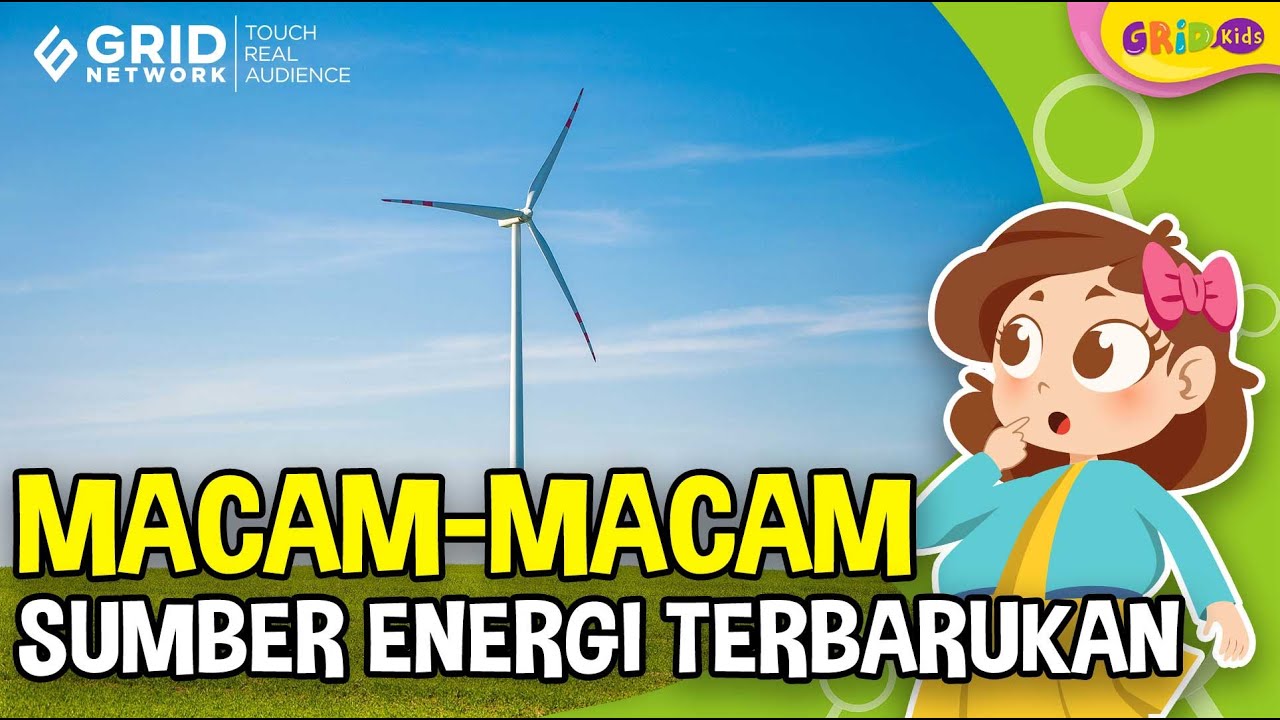Mari Mengenal Energi Baru Terbarukan
Summary
TLDRThis educational script highlights the importance of energy in our daily lives, explaining how traditional fossil fuels like coal, oil, and natural gas are limited and harmful to the environment. It introduces renewable energy sources such as solar, wind, hydro, and biomass as sustainable alternatives. The script describes how solar panels convert sunlight into electricity, wind turbines harness wind power, hydro systems use water currents, and biomass involves converting organic waste into energy. It encourages learning about these renewable sources to reduce dependence on fossil fuels and protect the planet.
Takeaways
- 🌞 Energy from the sun is crucial for our daily life and can be harnessed through solar panels, which convert sunlight into electricity.
- 💨 Wind energy is generated when strong winds turn the blades of wind turbines, which are connected to a gear system and ultimately to a generator that converts kinetic energy into electricity.
- 💧 Hydropower is created by the flow of water in rivers or lakes, which spins a water wheel connected to a generator, transforming the water's kinetic energy into electricity.
- 🌿 Biomass energy comes from organic matter like animal waste, agricultural residues, and food scraps, which are broken down by bacteria in a container to produce methane gas that can be used as fuel or to generate electricity.
- 🌱 The byproducts of biomass energy production can be used as fertilizer to enrich the soil and support plant growth.
- 🚗 Fossil fuels, such as coal, oil, and natural gas, are finite resources that have a negative impact on the environment, causing pollution and contributing to global warming.
- 🌐 The Earth's temperature is rising due to the use of fossil fuels, which is a significant concern for the sustainability of our planet.
- 🔋 Renewable energy sources, like solar, wind, and hydropower, are abundant and can help reduce our reliance on fossil fuels, promoting a more sustainable future.
- 🏡 Modern technology allows for the efficient use of renewable energy in homes and everyday appliances, making it a viable alternative to traditional energy sources.
- 🌱 Learning about and managing renewable energy sources is essential for a future where we can enjoy the benefits of electricity without depleting the Earth's resources.
Q & A
What is the primary source of energy that we use in our daily lives?
-The primary source of energy we use in our daily lives comes from fossil fuels such as coal, oil, and natural gas.
How were fossil fuels formed millions of years ago?
-Fossil fuels were formed millions of years ago from the remains of ancient organisms that absorbed sunlight and produced energy through photosynthesis. After their death, they were buried under the sea, and their energy was trapped within their bodies.
What are the negative impacts of using fossil fuels?
-The use of fossil fuels has negative impacts such as pollution that can contaminate air, water, and soil, and it contributes to global warming.
Why are fossil fuels considered unsustainable?
-Fossil fuels are considered unsustainable because they are finite resources, and if we continue to use them at the current rate, they will eventually deplete.
What is the alternative to fossil fuels mentioned in the script?
-The alternative to fossil fuels mentioned in the script is renewable energy sources, which are abundant and can be replenished naturally over a relatively long period of time.
How does solar energy work as a renewable energy source?
-Solar energy works by using photovoltaic panels that absorb sunlight and convert it into electrical energy, which can then be used to power electronic devices in our homes.
What is the role of wind energy in renewable energy sources?
-Wind energy is harnessed by wind turbines, where the wind's force turns the turbine blades, which are connected to a gear system that spins a generator to convert the kinetic energy into electrical energy.
How can water currents be used to generate electricity?
-Water currents can be used to generate electricity by using the flow of water as a driving force to turn water wheels connected to a generator, which then converts the mechanical energy into electrical energy.
What is biomass energy, and what are some examples of biomass materials?
-Biomass energy is energy derived from living organisms. Examples of biomass materials include animal waste, agricultural residues, forest waste, and food scraps.
How is biomass energy converted into usable forms of energy?
-Biomass energy is converted into usable forms by collecting waste materials in a container where bacteria break down the materials into methane gas, which can be stored and used as fuel for cooking or generating electricity through a generator.
What is the potential future impact of using renewable energy sources as described in the script?
-The script suggests that by using renewable energy sources, we can reduce our dependence on fossil fuels, enjoy the benefits of electricity, and also protect the Earth's environment for a sustainable future.
Outlines

このセクションは有料ユーザー限定です。 アクセスするには、アップグレードをお願いします。
今すぐアップグレードMindmap

このセクションは有料ユーザー限定です。 アクセスするには、アップグレードをお願いします。
今すぐアップグレードKeywords

このセクションは有料ユーザー限定です。 アクセスするには、アップグレードをお願いします。
今すぐアップグレードHighlights

このセクションは有料ユーザー限定です。 アクセスするには、アップグレードをお願いします。
今すぐアップグレードTranscripts

このセクションは有料ユーザー限定です。 アクセスするには、アップグレードをお願いします。
今すぐアップグレード関連動画をさらに表示

What's the Deal With Fossil Fuels? | California Academy of Sciences

IPAS KELAS 6 BAB 6 || TOPIK B: BENARKAH ENERGI AKAN HABIS? #kurmer

Energi Tidak Terbarukan Kelas 10 Kurikulum Merdeka | Pengertian, Sumber, Contoh Serta Manfaatnya

What are Fossil Fuels? How are they Formed? | Oil, Coal & Natural Gas

Macam-Macam Sumber Energi Alternatif untuk Kehidupan di Bumi

Fossil Fuel Formation | Lesson 6 | Earth Science
5.0 / 5 (0 votes)
